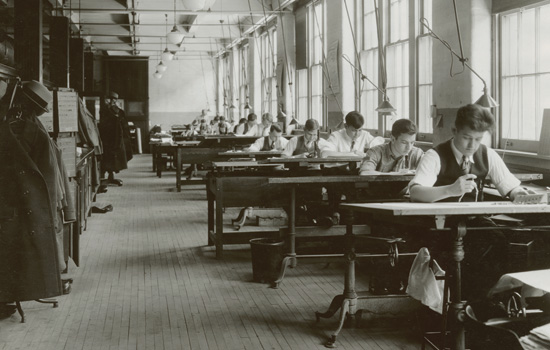A university of firsts: The past
At its founding in 1829, RIT launched a trajectory that today remains unique among the more than 4,000 U.S. colleges and universities occupying the higher education landscape. Consider the following early instances of “difference”:
1829
The provision of lifelong learning has been a strand of the RIT DNA from the inception of the Rochester Athenaeum, which offered evening lectures to the people of Rochester and was for a time the young city’s dominant cultural force.
1885
The Rochester Athenaeum and Mechanics Institute (the institution that would become RIT) commits itself to educating young men and women in the technologies necessary for successful careers— a mission that endures to this day. Early in its history, RIT becomes one of the first schools to integrate applied technical study with curricula in the humanities, the arts, and design. RIT may have been the first school to introduce “design thinking” into its curriculum.
1912
With the initiation of its cooperative education program, in which students secured paid employment in their major field, RIT becomes a pioneer in experiential education, or what today would be called competency-based education.
1950
The Graphic Arts Research Center is established to apply scientific and engineering principles to the printing and publishing industry. RIT becomes a center of research on all aspects of the graphic arts.
1950
School for American Craftsmen, founded by Aileen Vanderbilt Webb and now called School for American Crafts, moves to RIT. The school offers undergraduate and graduate programs in ceramics, glass, metals and jewelry design, and furniture design.
1960
RIT appoints Edwina Hogadone as the first female dean of a U.S. business college.
1968
National Technical Institute for the Deaf opens at RIT, revolutionizing technical education for the deaf and hard of hearing. At least two dozen universities vied for the privilege of hosting NTID, but RIT’s strong post-secondary technical curricula and cooperative education programs gave it the edge.
1971
RIT delivers its first distance-learning course via closed-circuit television.
1982
RIT enrolls students in the first undergraduate program in microelectronic engineering in the U.S.
1983
RIT becomes the first university in the nation to offer a Bachelor of Science degree in biotechnology.
1990
RIT’s Ph.D. program in imaging science opens—the first doctoral program at RIT and the first such program in the United States.
1991
RIT delivers its first fully online program—years before the rest of higher education enters the online arena.
1993
RIT offers the first nationally recognized Bachelor of Science degree in information technology.
1996
RIT becomes the first university in the United States to offer a bachelor’s degree in software engineering.
1998
RIT’s College of Engineering becomes Kate Gleason College of Engineering— the first engineering school in the country named for a woman.
2008
RIT offers a doctoral program in sustainability, the first program in the world to focus on sustainable production systems.
More on the Strategic Plan:
Greatness Through Difference: Preface
A University of Firsts: The Past
A University of Innovation: The Present
A Responsive University: The Context
The Power of Diversity: The future
Dimension I: Career Education and Student Success
Dimension II: The Student-Centered Research University
Dimension II: Leveraging Difference
Dimension IV: Affordability, Value, And Return on Investment
Dimension V: Organizational Agility
Already Great and Making a Difference















